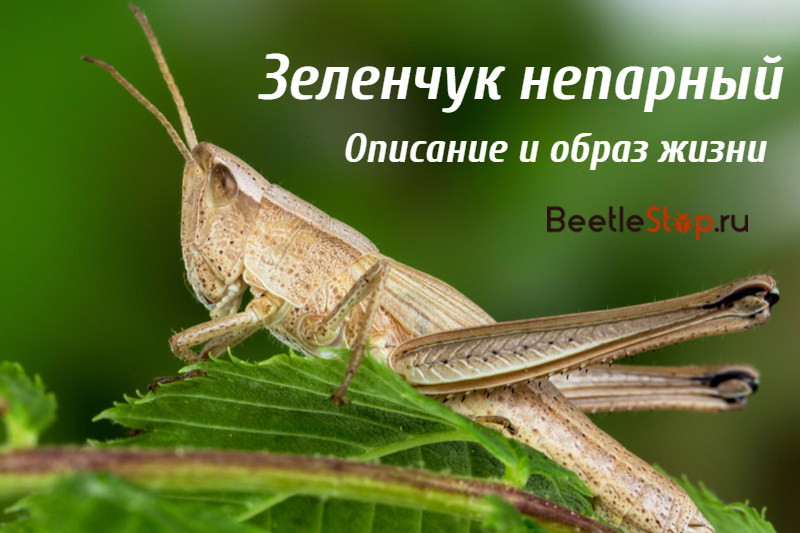Zelenchuk is unpaired - the appearance of the partner does not matter
Male and female species of Zelenchuk unpaired are so different in appearance that they can be mistaken for representatives of various genera. Medium-sized insects are widespread in the Palearctic. They inhabit wet meadows and swamps. Zelenchuk males make interesting sounds, like tweets, consisting of several syllables.

View description
Zelenchuk unpaired (Chrysochraondispar) - one of the species of a large locust family. The body of insects consists of three sections: head, chest and abdomen. Head elongated, triangular in shape, sloping forehead. The xiphoid antennae at the base are flatter and wider. Facet type eyes.
The pronotum is divided into two equal parts by the middle keel. Throughout it is solid, intersected by small grooves. Side keels are sharp. Flat on posterior margin of pronotum. Appendages are attached to the chest - 3 pairs of legs and wings. The front and middle legs are walking type, the hind legs are hopping. The hips of the hind legs are flattened, ribbed on the outside. Shin and thigh are the same length. The foot consists of three segments, between the claws there is a long suction cup.
Information. Zelenchuk limbs are thin and slender, they make insects look like grasshoppers.
Sexual dimorphism
In addition to the general structural features of the body, characteristic of all representatives of the locust family, male and female individuals of unpaired Zelenchuk have significant differences in appearance. Females of medium size, length 22-30 mm. The body is cigar-shaped, in the center there is a thickening. There are two forms of insects:
- Short-winged - elytra lobate, with a pointed apex. The backs are almost touching. The wings are rudimentary. Insects do not fly.
- Long-winged - elytra narrow, lanceolate, leathery. Well developed. Below them are a pair of transparent wings with thick venation. Wingspan up to 7 mm.
The color is variable, there are individuals of pink-brown with a metallic sheen, gray and greenish-orange. Sometimes the body is covered with dark spots and dots. For the long-winged form, a dark green color is typical. The ovipositor is hook-shaped - the top of the cusps is curved.
Males are smaller than females, their body size is 16-19 mm. Common color is bright green with a golden metallic sheen. The lower legs and the inside of the thighs are yellow. The length of the antennae exceeds the size of the head and pronotum by 2 times. Rounded elytra reach the end of the abdomen.
Habitat and habitat
Unpaired Zelenchuk can be found in almost all regions of Eurasia. The northern border of distribution in Europe is Scandinavia, the southern - Greece. In the east, insects live in the territory up to the Pacific Ocean. Locusts are absent on the islands of the Mediterranean, as well as in the UK. In Russia, the species is common in the European part, Buryatia, in the southern part of Siberia and the Urals, in the Caucasus.
Zelenchuk settle in moist meadows and swamps, where mainly cereal, bluegrass and sedge crops grow. These plants are feed for larvae and adults.
Lifestyle
Adults appear early in late June. The activity of insects continues until the onset of autumn. Some individuals are found in October. The populations are small.Long-winged forms are less common.
Zelenchuk songs consist of short phrases, repeated at intervals of 5-10 seconds. Sounds are quite loud, they can be heard at a distance of several tens of meters. Chirping includes 3-9 syllables.
Breeding
Unlike other species, Chrysochraondispar females leave clutch not in the ground, but in the stems of plants. They immerse their ovipositor in the core of dried bushes of raspberries, blackberries and other plants. Usually, a place for breaking is chosen, through which it is easier to get to the soft tissues. The female immerses the ovipositor 40 mm, leaving the eggs with a foamy secret. After drying, a small egg is formed.
With the onset of cold weather, the development of the embryo stops, diapause sets in. In the spring, when the air warms up enough, the embryos begin to grow. Larvae appear in late May or early June. Outwardly, they are similar to adults, but differ in small size and lack of wings. In the development process, 4 molting occurs. After each dumping of the old shell, the length of the body increases, the size of the wing primordia, the number of antenna segments.
In some countries, the unpaired Zelenchuk population is gradually declining. The species lives locally, therefore it is completely dependent on the conditions of the selected site. The economic activity of draining swamps and meadows destroys natural biotopes. Insects are listed in the Red Book of Belarus in the third category - as a species at risk of extinction.

